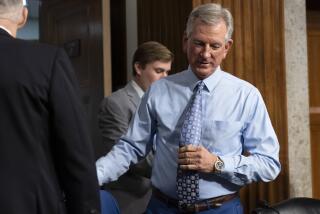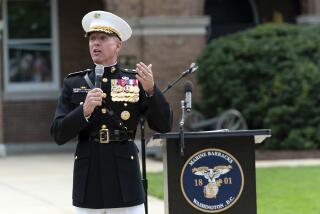Air Force General Gets Nod to Head Joint Chiefs of Staff
WASHINGTON — Air Force Gen. Joseph W. Ralston, a calm and consensus-seeking former fighter pilot, has been chosen by Defense Secretary William S. Cohen to succeed Army Gen. John M. Shalikashvili as chairman of the Joint Chiefs of Staff, defense officials said Friday.
Ralston, vice chairman of the Joint Chiefs for the last two years, has won wide support in the uniformed and civilian ranks of the Pentagon with his collegial oversight of a just-completed internal review. But his selection may disappoint some reform advocates who had hoped for the appointment of iconoclastic Marine Gen. John Sheehan, commander of the U.S. Atlantic Command, who likely would bring about more sweeping changes in U.S. forces for the new century.
“Sheehan was the candidate of change and uncertainty. People wanted the former, but maybe not too much of the latter,” said one top officer.
Ralston’s selection is expected to be announced next week after a White House meeting between President Clinton and Cohen.
The choice of Ralston is also another sign of the cautious approach that Cohen, the Cabinet’s only Republican, so far has taken in running the largest federal department. Since his confirmation on Jan. 24, Cohen rarely has stepped out front as a spokesman for administration foreign policy aims, and he has made few decisions--including in the major internal review--that risked a serious breach with the Pentagon’s uniformed leadership.
Ralston was the choice not only of Cohen but of Shalikashvili, Deputy Defense Secretary John White and the service chiefs. He has good relations with Congress, which is important for the administration’s goal of completing his confirmation by Sept. 30, when Shalikashvili will end his second two-year term as chairman.
Ralston is considered to have a sophisticated grasp of the complex technical issues involved in running today’s armed forces, as well as sensitive political antennae. But several officers predicted that he would resist if the Pentagon’s masters in Congress brought pressure to ease the military’s rules on adultery and sexual relations between the ranks, a hot-button issue at the moment.
Some officers suggested that Ralston might be a more public figure than Shalikashvili, who has been far less visible as chairman than, for example, retired Gen. Colin L. Powell.
*
Before his stint as vice chairman, Ralston, 53, was head of the Air Combat Command, which is based in Langley, Va., and oversees all Air Force combat aircraft. Earlier, he was in charge of the 11th Air Force, based at Elmendorf Air Force Base near Anchorage. He is also a Vietnam War veteran who flew 147 missions over that country and Laos.
Sheehan, 56, had won good grades for his contribution in helping oversee the U.S. intervention in Haiti. He would have been the first Marine chairman--the kind of precedent that often appeals to Clinton in personnel choices.
But while Sheehan was considered Cohen’s early odds-on favorite, he had upset some in the Pentagon by publicly criticizing the department’s huge bureaucracy and its centralization around Washington, and by calling on the North Atlantic Treaty Organization to slim down. He irritated some in the Air Force by questioning the primacy of air power, and, on occasion, he has broke ranks with the Marine commandant, Gen. Charles Krulak.
As a candidate for Joint Chiefs chairman, “he had shown all his cards right away,” one senior officer said.
In contrast, Ralston showed his deference to what each of the services held dear. That attitude may have arisen in part from his work as vice chairman in leading the effort to make the military services work together more closely in joint operations.
And in the Pentagon study, the congressionally mandated Quadrennial Defense Review, Ralston indicated that the services would get what they think they need. At the outset of the study, he indicated that he would not challenge the Navy’s desire to retain operation of all 12 aircraft carriers and he lined up with proponents of developing the new V-22 Osprey tilt-rotor aircraft for the Marines.
The study, released May 19, proved to be a document of incremental rather than sweeping change. It called for reductions of 60,000 active-duty troops across all the services and proposed funding new weapons through two new rounds of base closings--an idea with wide support in the military, if not in Congress.
More to Read
Sign up for Essential California
The most important California stories and recommendations in your inbox every morning.
You may occasionally receive promotional content from the Los Angeles Times.











